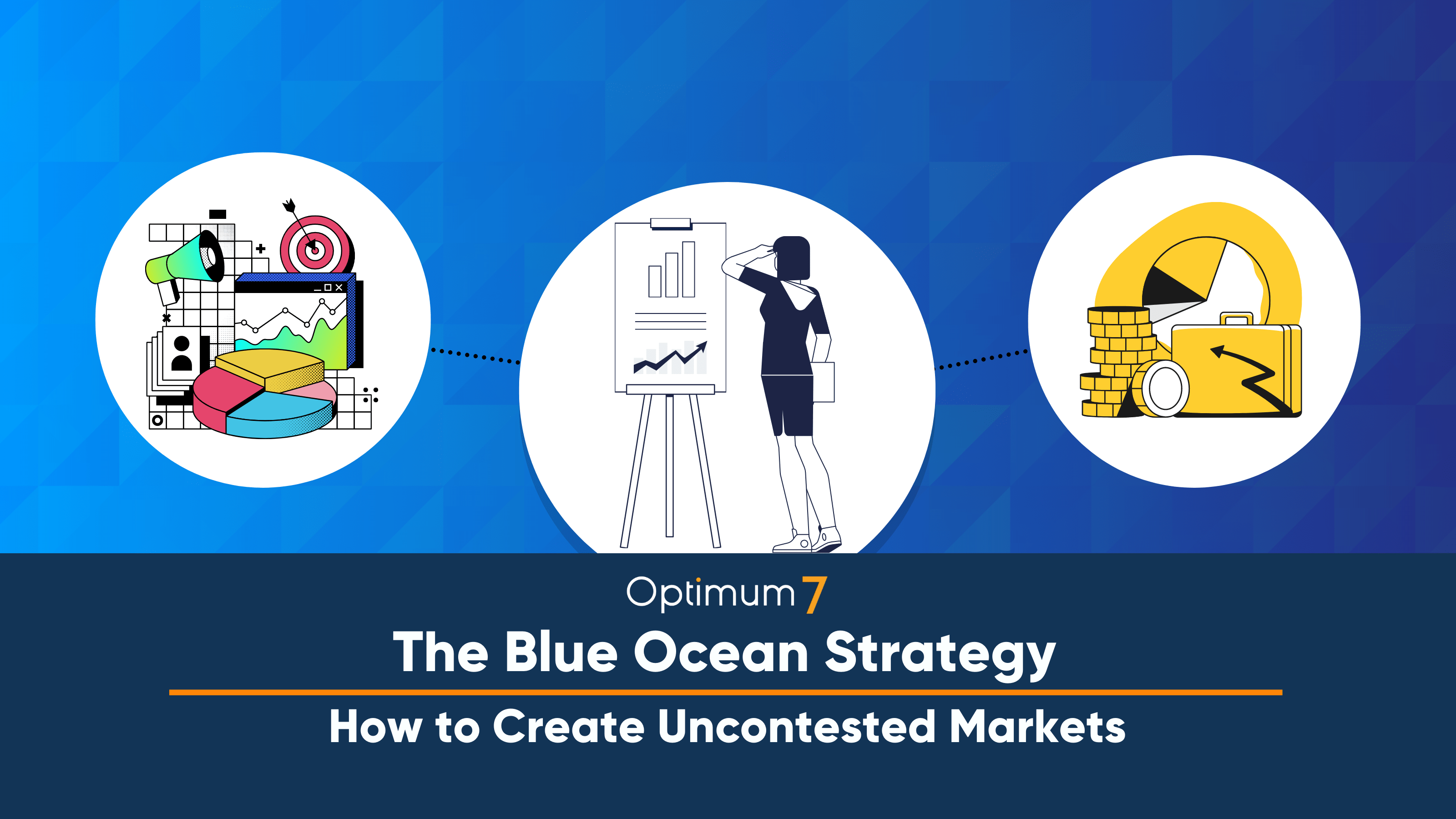The Blue Ocean Strategy offers an escape from saturated markets. Netflix exemplified this by reinventing video rentals with an online subscription model, bypassing traditional video rental competition at the time. This innovative shift not only transformed the industry but also set the stage for Netflix’s dominance as a streaming service.
The Blue Ocean Strategy is about creating new, uncontested market spaces—termed “blue oceans”—where competition is irrelevant. Rather than fighting for dominance in overcrowded industries, with the blue ocean strategy, businesses discover or invent unique markets with ample growth opportunities.
At its core, the Blue Ocean Strategy is about innovation and differentiation. It challenges businesses to shift their focus from competing within traditional boundaries to exploring new possibilities. This not only helps them stand out but also enhances their potential to attract new customers and significantly boost profits.
However, venturing into blue oceans is not without its challenges. Identifying truly uncontested spaces can be complex, and the sustainability of these markets can be threatened as they mature and attract competitors.
In this article, I will break down every aspect of the blue ocean strategy from ideation to implementation. We’ll go over practical examples of how world-renown companies have used it and how you can too.
Key Takeaways
- The Blue Ocean Strategy encourages stepping away from fiercely competitive markets (red oceans) to create and dominate new market spaces (blue oceans).
- Core to the strategy is value innovation, which involves delivering superior value to customers while simultaneously reducing costs.
- Discover blue oceans by adapting proven business models to new regions, identifying niche markets within established sectors, or innovating entirely new markets based on unserved needs and emerging trends.
- Case studies of Southwest Airlines, IKEA, and Liquid Death illustrate successful applications of the strategy in different industries.
- At Optimum7, our marketing team helps our clients clarify their positioning and highlight their unique value proposition in the market.
The Essence of the Blue Ocean Strategy
Developed by W. Chan Kim and Renée Mauborgne, the Blue Ocean Strategy presents a radical shift in thinking about business strategy. It moves away from traditional competitive strategies, which often lead to bloody “red oceans” saturated with competitors, and focuses instead on discovering or creating “blue oceans.” These are untapped new market spaces with opportunities for highly profitable growth.
Principles of the Blue Ocean Strategy
The framework is built on two fundamental principles: Value Innovation and the Market Shift.
Value Innovation is the linchpin of the Blue Ocean Strategy. It focuses on innovation that significantly increases value for customers and simultaneously reduces costs for companies. With value innovation, your business not only becomes different but also cost-effective.
The Market Shift refers to moving from red to blue oceans by targeting new markets or submarkets that the competition isn’t currently targeting. This concept is about redefining market boundaries and creating demand where none existed to make competition irrelevant.
How to Implement the Blue Ocean Strategy
Successfully adopting the Blue Ocean Strategy requires businesses to explore new markets—areas that are either non-existent or just emerging. These markets present vast opportunities for strategic innovation and growth.
Unestablished markets are characterized by their lack of existing competitors and solutions. They often represent areas where consumer needs are either completely unmet or poorly served by current market offerings. Successfully entering these markets demands an ability to recognize “unseen potential”, transforming untapped spaces into thriving markets.
Strategies to Identify Blue Oceans
There are 3 main approaches to discovering a blue ocean:
1. Adapt Successful Business Ideas to New Geographical Areas
A strategic approach to blue ocean strategy is taking a proven business model from one region and introducing it to another where the concept does not yet exist. This involves understanding the cultural, economic, and regulatory landscapes of new markets to tailor the business model appropriately.
The Samwer brothers are masters at this. Their company Rocket Internet is a prime example of the geographic adaptation strategy. They have famously taken successful business models from the U.S., such as Zappos, and adapted them for untapped European markets. Their company, Zalando, mirrored Zappos’ business model but was tailored to meet the distinct tastes and regulations of European countries. This approach not only filled a market void but also leveraged the established operational playbook of a successful American service, minimizing risk and maximizing efficiency.
2. Find Niches within Existing Markets
Investigate subsegments within established markets where consumer needs are still not being fully met. This involves a granular analysis of market data, customer feedback, and competitive offerings to spot gaps that represent potential for innovation.
Blue Apron is a prime example of successfully identifying and capitalizing on a subniche within the food and meal delivery market. By offering meal kits with pre-portioned ingredients and easy-to-follow recipes, Blue Apron targeted busy professionals and health-conscious consumers who wanted the convenience of cooking at home without the hassle of meal planning and grocery shopping. This innovative approach led to the company’s rapid growth and successful IPO in 2017, demonstrating the power of addressing specific unmet needs within an existing market
3. Identify Unserved Needs & Emerging Trends
This last strategy is the hardest to implement since it requires more creativity and vision. Contrary to the first 2 approaches which used an existing market and offer to derive a new market (and/or offer), this third approach requires creating one from scratch.
You can start by leveraging both personal experiences and target audience insights to uncover needs that current market offerings do not address. This could involve qualitative research methods like interviews, focus groups, or ethnographic studies to gain deeper insight into consumer frustrations and desires.
You should also keep track of global trends, technological advancements, and demographic shifts to identify markets that are beginning to form but are not yet fully recognized or served by existing players. Monitoring industry reports, attending international conferences, and analyzing trend forecasts can provide early signals of emerging opportunities.
Airbnb identified a gap in the hospitality market by providing a platform for homeowners to rent out their properties to travelers, addressing the unserved need for affordable, flexible, and unique accommodations. By tapping into the sharing economy and the trend towards experiential travel, Airbnb created a new market space that disrupted the traditional hotel industry. This innovative approach led to rapid growth and a valuation of over $30 billion by 2020, demonstrating the power of addressing unserved needs and emerging trends effectively.
Benefits of Blue Ocean Strategy
The Blue Ocean Strategy offers many benefits for businesses that successfully implement its principles. By shifting focus from competitive battlegrounds to new, uncontested market spaces, companies can achieve significant growth and reshape market dynamics. Here are some of its key benefits:
Less Competition
One of the most compelling advantages of the Blue Ocean Strategy is the creation of a market space where there is little to no competition. In Blue Oceans, businesses can operate without the constant pressure of competing on price or features within saturated markets. This lack of competition allows for greater control over pricing and business models, as well as the opportunity to set industry standards without direct challenges from rivals.
Greater Potential for Growth
Blue oceans represent untapped market spaces with vast potential for growth. These are opportunities that have not been exploited by any company, offering a fertile ground for innovation and expansion.
By creating and capturing new demand, businesses can enjoy rapid growth as they are not just sharing but actually growing the total market pie. This expansive potential is particularly crucial in industries that are either stagnant or declining, where red oceans are crowded and growth prospects are limited.
Ability to Shape Market Trends
Companies that pioneer blue oceans have the unique opportunity to shape market trends and influence consumer preferences. Since these businesses are the first to explore new market spaces, they can establish and define the rules of the game.
This leadership position allows them to set benchmarks and standards that subsequent entrants must follow, thereby shaping the direction of the industry. Being a trendsetter not only establishes the company as a market leader but also enhances its reputation and brand value.
Sustainable Competitive Advantage
The innovations and value propositions developed as part of a Blue Ocean Strategy are often hard for competitors to replicate quickly. This provides a sustainable competitive advantage, allowing the pioneering company to enjoy an extended period of market exclusivity. The unique blend of value innovation and strategic positioning makes it challenging for competitors to offer the same value without substantial investments or overhauls in their existing business models.
Cost Efficiency
Contrary to popular belief, pursuing blue oceans can lead to greater cost efficiency. This is because value innovation focuses not just on differentiation but also on lowering costs. By eliminating and reducing the factors an industry competes on, companies can not only create new value for customers but also streamline their operations and reduce unnecessary expenditures.
In summary, the Blue Ocean Strategy enables companies to break free from the intense competition of red oceans and explore new markets that offer substantial growth opportunities, less competition, and the ability to be at the forefront of market innovation.
Risks and Challenges
While the Blue Ocean Strategy offers significant advantages, implementing it is not without risks and challenges. Here’s a closer look at some of the main obstacles that businesses might encounter when adopting the Blue Ocean Strategy:
Uncertainty of Market Response
One of the most significant risks associated with the Blue Ocean Strategy is the uncertainty of market response. Since blue oceans involve creating a new market space that did not previously exist, there is no guarantee that the customer demand will materialize as anticipated.
Innovations might be ahead of their time, and customers may not be ready or willing to adopt the new offer. The lack of historical data and market benchmarks can make it challenging to predict how these new markets will respond, which can result in costly missteps.
Difficulty of Maintaining a Monopoly
Even if a company successfully creates a blue ocean and experiences initial success, maintaining that lead and monopoly can be difficult. Over time, as the market proves to be profitable, other companies will inevitably enter the space, increasing competition.
Protecting the newly created market from imitators requires continuous innovation and possibly legal protections such as patents. However, these may not always provide a complete barrier to competitors, who might find alternative ways to capitalize on the newly created demand.
Execution Complexity
The complexity of executing a Blue Ocean Strategy should not be underestimated. It requires a deep understanding of current market trends, customer needs, and potential technological advancements.
Additionally, organizations must cultivate a culture that supports risk-taking and innovation, which is not always easy. Misalignment between the strategy and the company’s capabilities can lead to failed initiatives and wasted efforts.
Strategic Drift
In pursuit of new opportunities, there is a risk that companies might stray too far from their core competencies. This can dilute the brand’s identity and alienate existing customers. Balancing innovation in new markets while maintaining traditional business lines is important to avoid confusing the market and damaging established relationships.
In summary, while the Blue Ocean Strategy has the potential to unlock new markets and drive significant growth, it requires careful planning, execution, and ongoing innovation to overcome the associated risks and challenges.
Case Studies: Blue Ocean Strategy in Practice
Southwest Airlines
Background:
Southwest Airlines was founded with the aim of serving as a low-cost carrier in the highly competitive airline industry. Up until they penetrated the market, air travels were considered a luxury. By targeting price-sensitive customers who typically opted for alternative transportation like cars or buses for inter-city travel, Southwest positioned itself uniquely in the market.
Strategy:
The airline adopted a no-frills service model that focused on point-to-point flights and quick turnaround times, significantly reducing operational costs. They eliminated assigned seating and first-class cabins, streamlining service to enhance efficiency.
Their friendly customer service and straightforward pricing without hidden fees contrasted sharply with industry norms, making air travel accessible and straightforward. This strategic approach not only appealed to budget-conscious travelers but also created a new market of air travelers by transforming air travel into an everyday transportation option rather than a luxury.
IKEA
Background:
Before IKEA’s entry, the furniture market was dominated by expensive, bulky items that often required professional delivery and assembly. These products typically catered to wealthier households and didn’t offer much in terms of affordability or flexibility.
Strategy:
IKEA revolutionized this market by introducing stylish, functional, and affordable flat-packed furniture. This innovation significantly reduced costs related to logistics and storage, passing these savings onto the customer. Moreover, IKEA focused on a younger demographic, including young families and individuals moving into their first homes, who appreciated the combination of style, cost-efficiency, and the fun aspect of self-assembly.
The company’s extensive designs, from minimalist to modern, ensured broad appeal, further solidifying its market position. Their large, warehouse-like stores, where customers could browse extensive showrooms and pick up products in a self-service format, were also new at the time which made them even more unique.
Liquid Death
Background:
Liquid Death is a recent example of a company that was able to thrive by niching down. Liquid Death Mountain Water entered the crowded bottled water market in 2019, which was saturated with brands that largely focused on promoting health, wellness, and environmental consciousness. Most competitors used similar branding strategies, featuring serene natural landscapes, soft color palettes, and an emphasis on purity.
Strategy:
Liquid Death completely subverted these norms by adopting a branding strategy rooted in heavy metal and punk rock aesthetics. Its bold tagline, “Murder Your Thirst,” and its use of tallboy cans typically associated with beer targeted a demographic that was largely overlooked in the water market: young, rebellious consumers and those typically interested in the energy drink and craft beer scenes.
This audacious approach not only differentiated Liquid Death from its bland competitors but also tapped into a market segment that enjoys edginess and distinctiveness in brand personalities. Their strategy was to not just sell water but to sell a brand identity that resonated with a specific lifestyle, thereby creating a new market space that challenged conventional perceptions of what bottled water could represent.
Ready To Become An Industry Leader?
The Blue Ocean Strategy encourages businesses to move beyond competitive red oceans into blue oceans of untapped market spaces. It focuses on creating demand and making competition irrelevant through innovative approaches like adapting successful business models to new regions, identifying underserved market niches, and uncovering unserved needs.
Many successful businesses have adopted this strategy. We talked about a few throughout this article. I invite you to consider how the Blue Ocean Strategy might apply to your own business or career. As you reflect on these insights, think about areas where you can innovate and transform your industry.
If you need help finding unique opportunities to stand out in your industry, do not hesitate to reach out and we can talk about strategies to achieve that. We’ve helped 100s of businesses increase their visibility and revenue with our marketing approach. Chances are we can also help you!












